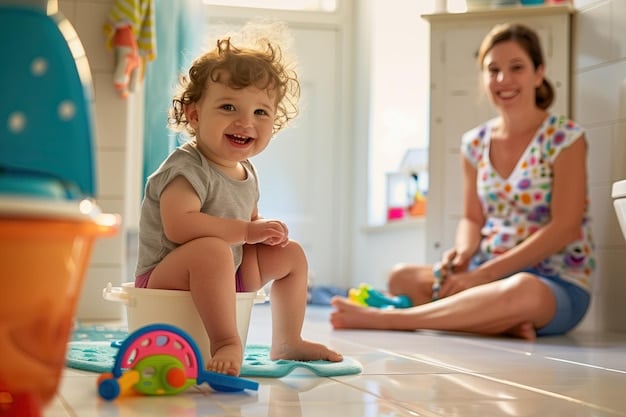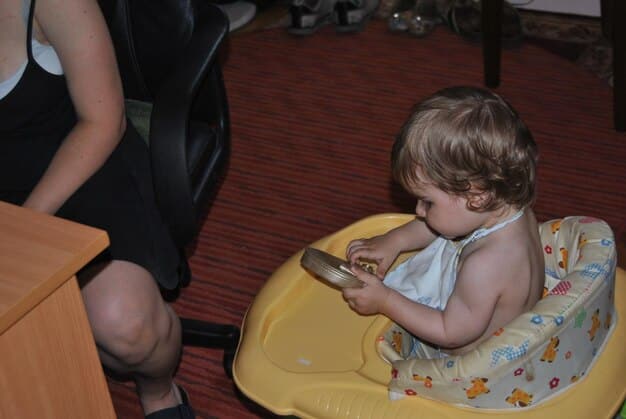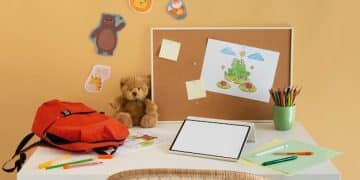Potty Training in 3 Days: A Quick & Effective Method

Potty Training Power-Up: The 3-Day Intensive Method offers a structured approach to help parents achieve faster results, transforming a potentially stressful milestone into a successful and positive experience for both child and caregiver.
Ready to ditch the diapers? The Potty Training Power-Up: The 3-Day Intensive Method for Faster Results is your go-to guide for a swift and successful transition, giving you and your little one a boost towards potty independence. Let’s dive in!
Understanding the 3-Day Potty Training Method
The 3-Day Potty Training Method is an intensive, focused approach designed to help children achieve potty training success in a short timeframe. Unlike gradual methods, this approach involves dedicating a concentrated period to actively teaching and reinforcing potty training skills.
The Core Principles
At its heart, the 3-day method prioritizes consistency and undivided attention. Parents commit to spending three full days guiding their child, recognizing and responding to cues, and celebrating successes.
Why Choose This Method?
Many parents opt for the 3-day potty training method due to its potential for rapid results. It can be particularly appealing for families seeking a faster solution or those who have experienced frustration with more prolonged approaches.
- Efficiency: Achieves potty training milestones faster.
- Focused Attention: Dedicates a specific timeframe to the process.
- Consistency: Provides a consistent learning environment for the child.
In summary, the 3-Day Potty Training Method is an accelerated approach that requires commitment and focus but can lead to quicker results in potty training.
Preparing for the 3-Day Potty Training Blitz
Before diving into the 3-Day Potty Training blitz, thorough preparation is essential for a successful and stress-free experience. This involves creating the right environment, gathering necessary supplies, and ensuring that both you and your child are ready for the challenge.

Emotional Readiness
Evaluate your child’s emotional cues and maturity level. Look for signs like interest in using the toilet, ability to follow simple instructions, and discomfort with wearing a soiled diaper. Ensure that you’re mentally and emotionally prepared to dedicate three full days to the process.
Essential Supplies
Gather essential supplies such as a potty chair or toilet seat adapter, training pants or underwear, comfortable clothes, cleaning supplies, rewards, books, and activities. Having everything within reach minimizes distractions and maximizes your focus on potty training.
Setting the Stage
Create a potty-friendly environment by placing the potty chair in a convenient location and removing obstacles or distractions. Communicate the plan to your child with enthusiasm and positivity, setting clear expectations for the upcoming training period.
- Potty Chair Placement: Place it in an accessible and comfortable area.
- Open Communication: Talk to your child about using the potty.
- Eliminate Distractions: Create minimal distractions in the training area.
Overall, comprehensive preparation sets the foundation for a successful 3-Day Potty Training experience, equipping both parent and child with the tools and mindset needed to achieve positive results.
The Intensive 3-Day Potty Training Schedule
The heart of the 3-Day Potty Training method lies in a structured and consistent schedule designed to accelerate learning and promote success. By following a clear schedule, you can create a predictable environment that reinforces desired behaviors and minimizes accidents.
Day 1: Immersion and Introduction
Start the day by introducing the concept of using the potty. Explain the purpose of the potty chair and invite your child to sit on it fully clothed. Encourage regular potty breaks every 20-30 minutes, offering plenty of praise and encouragement for any attempts.
Day 2: Reinforcement and Rewards
Continue with frequent potty breaks, reinforcing positive behaviors with rewards and praise. Introduce training pants or underwear, emphasizing the importance of staying dry. Address accidents with empathy and use them as learning opportunities, gently reminding your child to use the potty next time.
Day 3: Independence and Mastery
Focus on fostering independence and mastery of potty training skills. Encourage your child to initiate potty breaks independently, offering support and guidance as needed. Celebrate successes enthusiastically and continue to reinforce positive behaviors with praise and rewards.
- Frequent Potty Breaks: Adhere to a strict schedule for regular breaks.
- Positive Reinforcement: Reward successes with praise and small treats.
- Accident Management: Handle accidents with empathy and patience.
In conclusion, the intensive 3-Day Potty Training schedule provides a structured framework for accelerating learning and promoting independence in potty training.
Troubleshooting Common Challenges
Potty training can present various challenges, despite careful planning and execution. Addressing common issues effectively can help maintain momentum, minimize frustration, and ensure continued progress toward potty training success.

Refusal to Sit on the Potty
If your child resists sitting on the potty, try making it more inviting by adding books, toys, or decorations. Use positive reinforcement and praise to encourage cooperation, and avoid forcing or pressuring your child into sitting.
Frequent Accidents
Minimize accidents by maintaining a consistent potty schedule and recognizing your child’s cues. Ensure that clothing is easy to remove, and provide gentle reminders throughout the day. If accidents persist, consult with your pediatrician or a potty training expert for additional guidance.
Regression
Potty training regression may occur due to stress, illness, or changes in routine. Address the underlying cause of the regression by providing extra support, reassurance, and encouragement. Revisit basic potty training principles and celebrate small successes to rebuild confidence.
- Refusal Strategies: Make the potty inviting and use positive encouragement.
- Accident Management: Be patient and stick to a consistent schedule.
- Regression Solutions: Provide extra support during stressful times.
In brief, troubleshooting common challenges in potty training involves patience, understanding, and a willingness to adapt strategies to meet your child’s individual needs.
Positive Reinforcement and Motivation Techniques
Positive reinforcement plays a pivotal role in motivating children and reinforcing desired behaviors during potty training. By using praise, rewards, and encouragement, parents can create a positive association with potty training and promote a sense of accomplishment.
Verbal Praise
Offer enthusiastic verbal praise for every attempt, regardless of outcome. Use positive language and specific feedback to reinforce desired behaviors, such as “Great job trying!” or “I’m so proud of you for telling me you needed to go!”
Tangible Rewards
Implement a reward system to motivate your child and celebrate milestones. Offer small treats, stickers, or privileges for successful potty breaks, gradually phasing out rewards as your child becomes more independent. This encourages them to associate potty training with positive outcomes.
Creating a Fun Environment
Turn potty training into a fun and engaging experience by incorporating games, songs, or books. Make the potty area inviting and accessible, and create opportunities for your child to practice potty training skills in a playful setting.
- Verbal Encouragement: Praise every attempt to use the potty.
- Small Rewards: Use treats or privileges for successful potty breaks.
- Engaging Activities: Make potty training fun with games and books.
Ultimately, positive reinforcement and motivation techniques can greatly enhance the potty training experience, fostering a sense of confidence and accomplishment in your child.
Maintaining Consistency After the 3 Days
Sustaining progress after the 3-Day Potty Training period requires ongoing consistency and reinforcement of learned behaviors. Establishing routines, setting expectations, and addressing setbacks can help maintain momentum and ensure long-term success.
Establishing a Routine
Incorporate regular potty breaks into your daily routine, such as upon waking, after meals, and before bedtime. Maintaining a consistent schedule helps reinforce positive habits and reduces the likelihood of accidents.
Continued Reinforcement
Continue to praise and reward your child for using the potty independently. Provide gentle reminders as needed, and celebrate achievements to reinforce positive associations with potty training.
Addressing Setbacks
Be prepared for occasional setbacks or regressions, especially during periods of stress or change. Respond with patience and understanding, and revisit basic potty training principles as needed.
- Daily Schedule: Regular potty breaks in the daily routine.
- Consistent Praising: Praise child for independent potty use.
- Understanding Setbacks: Patience during regressions and extra support.
In summary, maintaining consistency after the 3-Day Potty Training period is essential for solidifying progress and fostering long-term potty training success.
| Key Point | Brief Description |
|---|---|
| 🚽 Readiness Assessment | Ensure the child shows signs of readiness like interest in the toilet. |
| 📅 Structured Schedule | Follow a consistent schedule of frequent potty breaks over three days. |
| 🎉 Positive Reinforcement | Use praise and rewards for successes to build positive associations. |
| 💪 Consistent Approach | Maintain the routine and positive reinforcement after the initial three days. |
Frequently Asked Questions
▼
The 3-day method is most effective for children who show signs of readiness, such as interest in the toilet and the ability to follow simple instructions. However, every child is different, and some may require a more gradual approach.
▼
Accidents are a normal part of the process. Handle them with patience and empathy, using them as opportunities to remind your child about using the potty next time. Avoid scolding or punishing them, as this can create negative associations.
▼
Nighttime potty training may take longer than daytime training. Limit fluids before bedtime, encourage a potty break right before sleep, and consider using a waterproof mattress protector. Patience and consistency are key.
▼
Rewards can be small treats, stickers, or privileges. Choose rewards that motivate your child but aren’t essential for their well-being. Gradually phase out rewards as your child becomes more independent in using the potty.
▼
If the 3-day method isn’t successful, don’t be discouraged. Every child learns at their own pace. Consider other potty training methods or consult with your pediatrician for additional guidance and support.
Conclusion
The Potty Training Power-Up: The 3-Day Intensive Method for Faster Results can be a game-changer for families seeking a quicker path to diaper-free days, offering a blend of structured guidance and positive reinforcement to help your child achieve potty training success efficiently.





